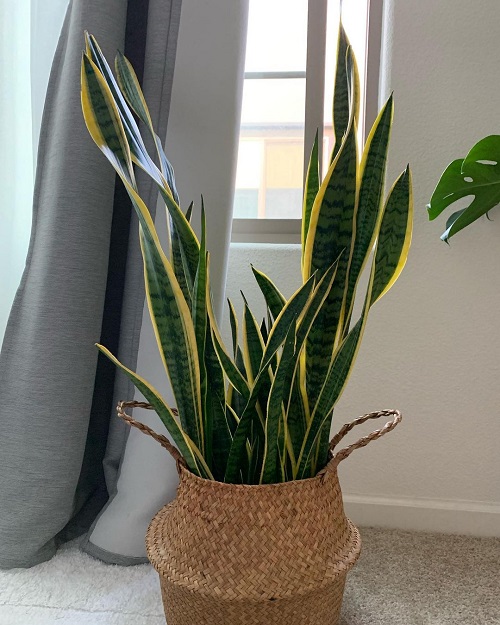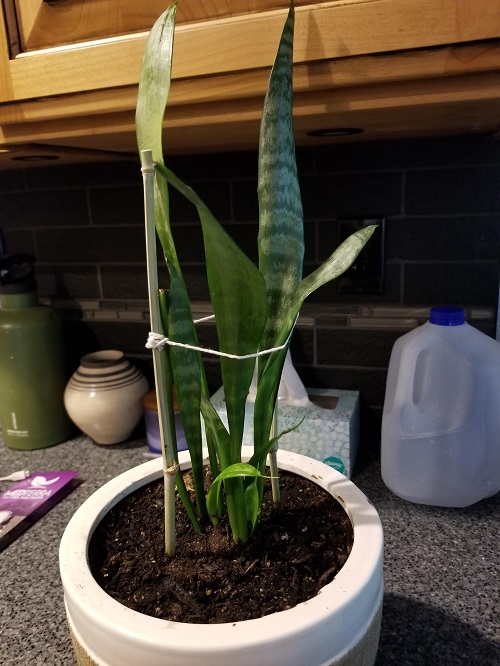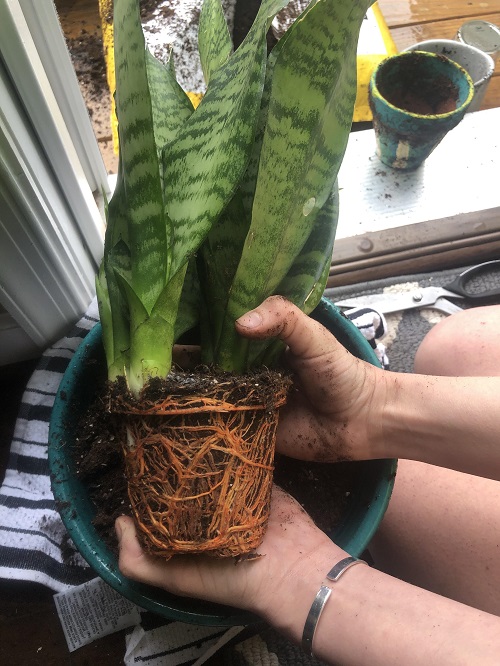An upright Snake Plant looks modern and architectural, but if your Mother-in-Law’s Tongue has leaves that are bending and falling over, read this!
Snake plants are popular for their modern, sword-like, deep green, and variegated foliage that grows upright.
These leaves, if erect and tall, can accentuate the architectural beauty of this popular houseplant, which is why these tricks for upright snake plants is worth knowing.
Tricks for Upright Snake Plants
1. Choose the Variety that Grows Upright

Snake plants are known for their tall, upright leaves. However, some varieties have a different look.
Take the Sansevieria kirkii, for example. Its leaves spread out like a crown and may droop as they age. Similarly, the Sansevieria parva has narrow leaves that curve outwards.
If you have one of these types, they’ll never grow upright, so you need a cultivar with an upright growth habit.
You should select a snake plant variety that has an upright growth habit–Sansevieria laurentii, Sansevieria stuckyi, Sansevieria cylindrica, and Sansevieria bacularis are great options!
2. Stake It

Staking helps a snake plant grow upright by supporting its tall and slender leaves, which can sometimes bend down as it grows.
This is especially useful for tall snake plant leaves or when plants kept in spots where they might not get enough light–weaker leaves are more likely to drop.
It’s also helpful when it has been transplanted recently; transplant shock is one of the biggest reasons why snake plant leaves fall over!
3. Provide Ample Light
Snake plants are often recommended as the greatest houseplants for low-light spaces because they can survive in shady conditions. However, they still need bright daylight to grow tall; otherwise, the leaves won’t stay upright.
To give your plant more light, keep it closer to a window or place it in a brighter spot, like a position near an east-facing window or corridor with dappled light. You can also let your plant get morning sunlight for 2-3 hours daily.
If the plant is near a south—or west-facing window, keep it slightly away from direct sun.
4. Grow it in a Warm Room

If a snake plant is kept in a cold room or regularly exposed to cold drafts, it can become stressed and have trouble growing. To prevent this, move your plant to a warmer room with a stable temperature around winter.
Keep the plant in a temperature range between 60 to 90 F (15 to 32 C). Protect it from sudden temperature changes, too much heat, and drafts, as these can mess with its health and ultimately result in not-so-upright leaves.
5. Keep It a Little Root Bound
Keeping the plant slightly root-bound for an upright growth is another neat trick. This helps it stay healthy, grow more pups (baby plants), and force it to bloom often. As this succulent thrives on neglect, just leave the plant as it is, and it will grow at its own sweet pace.
If you plan to re-pot the plant, check if the roots are tightly clumped together in a cylindrical shape. If they are, gently loosen them with your fingers to untangle and help the plant grow in its new pot; for more steps, don’t miss checking out these repotting tips. This new pot should only be one size bigger than the current one!
6. Don’t Overwater
Avoid overwatering, as it can lead to root rot and weaker stems, obstructing the snake plant from becoming tall and upright.
Inspect the soil every 2 weeks and water when it is almost dry from the top. Always saturate the plant thoroughly until water seeps out from the bottom.
If you’ve kept it indoors or in a place with milder light, the soil will dry up slower, so it’s best to wait even more and always check the soil before watering again by poking your index finger or moisture meter 1-2 inches deep in the growing medium.





